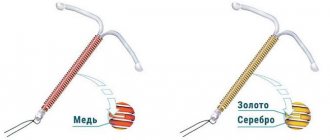Mirena is one of the modern safe methods of contraception; it is a special type of IUD (intrauterine device) that provides protection against unwanted pregnancy for 5 years. This intrauterine therapy system consists of a white hormonal elastomeric core placed on a T-shaped body and covered with an opaque membrane that regulates the release of levonorgestrel.
The levonorgestrel-releasing intrauterine system (IUD) has a primarily local progestational effect. Progestin (levonorgestrel) is released directly into the uterine cavity, which allows it to be used in an extremely low daily dose. High concentrations of levonorgestrel in the endometrium have a strong antiproliferative effect. When using Mirena, morphological changes in the endometrium and a weak local reaction to the presence of a foreign body in the uterus are observed. Thickening of the mucous membrane of the cervical canal prevents the penetration of sperm into the uterus. Mirena prevents fertilization due to inhibition of the motility and functional activity of sperm in the uterus and fallopian tubes. In some women, ovulation is also suppressed.
Previous use of Mirena does not affect reproductive function. Approximately 80% of women who want to have a child become pregnant within 12 months after removal of the IUD.
In the first months of using Mirena, due to the process of suppressing endometrial proliferation, an initial increase in spotting may be observed. Following this, pronounced suppression of the endometrium leads to a decrease in the duration and volume of menstrual bleeding in women using Mirena. Scanty bleeding often transforms into oligo- or amenorrhea. At the same time, ovarian function and the concentration of estradiol in the blood remain normal.
The appearance of brown or bloody discharge between periods in the first 3-6 months after insertion of the IUD is a common side effect of this method of contraception.
The presence of vaginal infections can provoke the appearance of brown discharge from the vagina; the IUD can become a conduit for infection and cause the development of pelvic inflammatory diseases (PID). In this case, the spiral must be removed and appropriate treatment must be performed.
What discharge is considered normal during an IUD?
Discharge after placement of the IUD is a common occurrence that causes concern for those who use it for the first time. There is no need to worry, because in most cases this is the norm. Experts say that such symptoms after the installation of an intrauterine device are a common side effect, which most likely means a normal reaction of the body rather than a pathological one.
Basically, this is a brown discharge that can begin a few days after the installation of the IUD, and it can last from several days to several months.
It is worth considering that this device is inserted shortly before the end of the menstrual period, therefore, spotting after installation may be the planned end of menstruation. This may be copious discharge of bloody mucus or minor spotting. It is also normal for such manifestations to occur between periods.
After insertion of the IUD, discharge may also occur due to the fact that small vessels of the endometrium (internal tissue of the uterus) were affected. Such bleeding is insignificant, but may be accompanied by nagging pain.
Brown discharge with a spiral may be a natural reaction of the body to a foreign object. This phenomenon can drag on for even six months. It is also not a violation of the change in the nature of menstruation: bleeding may become much stronger, or vice versa, the amount of blood will decrease.
After installing Mirena, the body may react to externally administered hormones with brown discharge. After a while, the hormonal balance will resume, and these phenomena will disappear.
If the bleeding does not go away for a long time, and the pain does not leave you, you should consult a doctor, because this is already a deviation from the norm.
Various complications
The most common period after the installation of an IUD when various complications appear is the first three months.
Spiral falling out. It is not necessarily accompanied by painful sensations and does not cause harm to the body. Sometimes a woman does not notice at all that the spiral has fallen out. Loss can occur either immediately after the procedure or for quite a long time after the insertion of the IUD. The cause of the IUD falling out can be heavy physical exertion and deformation of the cervix. Also, if an incompetent doctor installed the IUD incorrectly or chose an IUD that is unsuitable in size and type for the body. Sometimes prolapse occurs due to the harmless reason that the body does not accept a foreign object. In this case, after getting used to it, everything goes away.
Uterine bleeding - Bleeding from a woman’s uterus is not always dangerous. If there is bleeding after installing the coil, first of all you need to pay attention to the volume and timing of bleeding. If small amounts of blood are released over the course of several months, this is completely normal. You should consult a doctor if, after installing the IUD, heavy bleeding begins and continues for more than seven days, with severe pain. The doctor will prescribe treatment and determine whether to remove the IUD during treatment or not.
Perforation of the uterus. This complication occurs very rarely, but it does happen. If inserted incorrectly, the IUD damages the uterus. Other causes of perforation are the incorrect shape of the spiral, its type, or the spiral that is not suitable for the anatomical features of the uterus. After treatment of perforation, the IUD is not recommended for further use as a means of contraception.
Pathological discharge when using a spiral
Infection
This contraceptive is designed to protect a woman from unwanted pregnancy, but it does not perform a barrier function against various infections, viruses and fungi. Moreover, it is a kind of conductor for them and in some situations may even be the root cause of inflammation of the pelvic organs. This may be indicated by excessive bleeding with discomfort, or the presence of an unpleasant odor or greenish or yellowish mucus color.
Fixture offset
One of the complications that can cause bleeding during the installation of the coil is its loss or displacement. This includes both spontaneous violation of the position and rejection by the body. A foreign body is a fairly large load on a well-functioning reproductive system, so it can take this device for too long, letting bloody smears know about it, or not take it at all.
To avoid displacement of this remedy, it is not recommended to lift heavy objects, apply pressure, or have sex in the first 2 weeks after implantation. It is recommended to regularly check that the coil is in place to prevent movement. This can lead to injury to the genitourinary system, as well as unwanted pregnancy.
In 0.02% of cases of installation of this contraceptive, bleeding may be caused by damage to or puncture of the uterus. This occurs due to improper insertion or placement of the device. The phenomenon is very rare, but it does happen. In this situation, the main thing is to consult a doctor in time to avoid inflammatory processes and pathological injury.
Ectopic pregnancy
Since no contraceptive means can guarantee a 100% result, conception may still occur with the IUD. But if this happens, it will most likely be in the form of an ectopic pregnancy. A sure sign of this is brown and bloody discharge with increasing and prolonged pain. Follow the link to see what discharge may appear during an ectopic pregnancy.
The spiral has “tendrils” that expand the walls of the uterus. In rare cases, this may be indicated by an increased amount of blood released during menstruation.
Whatever the reason, you need to contact a specialist to determine the cause of the discharge. It is worth remembering that the problem does not go away on its own, and large blood loss can lead to anemia and other serious consequences.
Restoring the cycle after removing the IUD
After removal, the woman’s menstrual cycle gradually returns to the norms that were before its installation. If you have doubts or suspicions of any disease, it is better to consult a doctor.
Heavy periods
If a woman had decent discharge in the uterine cavity during menstruation against the background of an IUD, similar discharge may persist for another couple of months. But if your critical days are accompanied by pain, discharge with clots and an unpleasant odor, you should consult a doctor. Long-term use of an IUD is a risk factor for endometritis. Moreover, while wearing the spiral, a woman could develop fibroids and other pathologies.
Scanty menstruation
They are more common in women who had light periods before the IUD was installed. In addition, pregnancy should be excluded if the discharge is spotting.
Time after IUD removal
In terms of duration, periods also usually become shorter, since the coil itself provokes long-term spotting after the completion of the main discharge.
And here is more information about how to distinguish uterine bleeding from menstruation.
The intrauterine device is a reliable and inexpensive way to prevent pregnancy. But a foreign body in the uterine cavity provokes a change in the nature and duration of menstruation. For some, IUDs are not suitable at all - menstruation becomes so heavy and painful. The doctor’s task is to choose the most suitable IUD option for a woman; the variety of coils produced allows this to be done.
Reviews from women and specialists
Feedback from patients and specialists allows us to conclude that the intrauterine device is a highly effective means of contraception, which has been used abroad and in domestic practice for decades.
In recent years, the IUD has become affordable. It is easy to install, the procedure itself takes no more than 15 minutes. The process is painless if there are no contraindications, and it is carried out by an experienced specialist.
An additional advantage is that installation of this product is possible at any age. Some women in their reviews say that they had the IUD for almost the entire period of their reproductive years.
A natural occurrence when placing the IUD inside the uterus is discharge. As a rule, they are brown and have no foreign odor. Depending on the cause, such bleeding lasts from several days to six months.
Need for removal
There are many reasons why you need to remove the coil or replace it with a new one.
The need to remove the spiral may arise in the following cases:
- The hormonal intrauterine device needs to be changed after every five years of use, and the copper one after ten years.
- When using other protection against pregnancy, the IUD must be removed at the beginning of the menstrual cycle.
- After removing the intrauterine device, the next installation is made only after a month.
- If inflammation or infection occurs due to the coil, or if there is heavy bleeding, the coil must be removed.
- In case of individual intolerance to the IUD. If, when using an IUD, a woman has constant abdominal pain in the area of the uterus, or the blood of sexual intercourse experiences discomfort, the IUD must be removed and another method of protection must be used.
General information
The Mirena IUD is considered a highly effective means of preventing unwanted pregnancy. The active ingredient is levonorgestrel, a hormone that is released from the spiral from the first day of installation during the period of use. 20 mcg of the substance is released per day. After 5 years of use, the amount of hormonal content in 1 day is 10 mcg.
Taking into account the physiological norms and characteristics of the female body, manufacturers created a spiral from a core full of hormonal content and a membrane responsible for its gradual release.
Before installing the device, you need to take into account one important rule: the items in the packaging are sterile, therefore, if its integrity is violated, you must refuse to use such a contraceptive. Otherwise, after installing the coil, discharge may appear due to infection and the spread of the inflammatory process.
It is also worth considering that due to the introduction of a hormonal drug, the body needs at least 3 months to get used to its effect. The adaptation period may be accompanied by the appearance of bloody discharge.
Why does bleeding occur?
Light bleeding and scanty brownish smears for six months after insertion of the IUD are a natural phenomenon and should not bother a woman. In this case, bleeding after insertion of the spiral is the body’s adaptation to the foreign object. You need to see a doctor if the smears continue and do not stop for 8 months or more, and if after installing the IUD, bleeding continues for a long time or severe bleeding occurs.
Often in the first month after the procedure, girls experience a delay in menstruation. In this case, anti-inflammatory drugs are taken that normalize the cycle and protect against inflammatory processes in the uterus. Inflammation of the uterus occurs due to intolerance to the IUD as a type of contraceptive.
Types of spirals
Any intrauterine devices are made from polymers that are safe for the human body. For contraception purposes, a wide variety of products are used, which differ from each other in their shape, dimensional characteristics, and principle of operation. T-shaped tools are considered the most popular, as they are very easy to use and install. At the free end of the Mirena body there is a ring-shaped loop, which is necessary for fixing the thread with which the IUD is removed.
Spirals are distinguished according to their operating principle:
- neutral;
- medicinal;
- hormonal.
The neutral effect is that the introduced object is a foreign body that interferes with embryonic development. Such funds are large and do not provide maximum effectiveness in preventing unwanted pregnancy. They also provoke the appearance of heavy menstruation, accompanied by severe pain. When these IUDs are installed, women very often experience uterine bleeding.
Medicinal IUDs are also divided into several groups depending on the material that was used in the manufacture of the contraceptive. Spirals may contain:
Those products that contain copper are easy to install; they rarely cause any complications, including bleeding. But they have several contraindications in which use should be avoided:
- presence of inflammation;
- diseases of the pelvic organs;
- cervical erosion.
It is worth noting that the danger of erosion when installing a spiral should not be underestimated, since this disease requires mandatory monitoring and treatment.
When to see a doctor
Slight spotting or spotting is a natural reaction of the body after insertion of the IUD, as it occurs in almost all women. The average period is 6 months, but the time for cessation of discharge varies individually and can vary from 4 to 8 months. It happens that there is no discharge at all, but this is very rare and harmless.
Only prolonged and heavy discharge becomes dangerous. It's like having a period that doesn't stop for several weeks. If there is heavy bleeding, you should immediately consult a doctor. Also, if the discharge continues for quite a long time, it is better to visit the hospital, since severe bleeding and smears for more than 8 months can be caused by serious disorders in the body.
Sometimes the IUD in a woman can provoke various diseases of the uterus, then bleeding signals inflammation. If the examination reveals a negative effect of the spiral, it is removed and no longer installed. In this case, other methods of protection are prescribed.
Features of installing a spiral
The Mirena spiral is a hormonal system that is easy to install and has a low likelihood of complications. The principle of operation is that it does not allow sperm to penetrate into the upper areas of the woman’s reproductive system and blocks the processes of fertilization of the egg.
Also, after installing Mirena, cervical mucus thickens, which helps block the proliferative layer of the endometrium. This operating principle allows the product to maintain high effectiveness for a long time.
The installation procedure is quite quick, the woman does not experience any discomfort. If there are no contraindications, the gynecologist will schedule a day for the procedure. Basically, the product is installed at the end of menstruation. This takes about 15 minutes. The placement of the IUD in the uterine cavity is painless, as local anesthesia is administered.
However, if there is bloody discharge from the uterus, and it lasts for quite a long time, you need to consult a doctor. This will prevent the development of complications.
Menstruation after the IUD may be scanty, or, conversely, abundant, so we advise you to read a separate article on this topic.
Installation
Before going to the IUD insertion procedure itself, you need to carry out a number of preparatory measures: take tests prescribed by the doctor, undergo an examination by a gynecologist and carry out the procedure.
Examinations that must be completed before the procedure:
- Pregnancy testing;
- Taking HIV tests;
- Screening for STDs and other gynecological problems;
- Blood test for hepatitis C and other types;
- The doctor must examine the genital organs: vagina, uterus, etc. and then select the best type of IUD for the woman.
Before the procedure, the gynecologist measures the size and depth of the uterus. The process of installing an intrauterine device feels like inserting a gynecological speculum during an examination. There is no severe pain during the procedure, but there is some discomfort. If a woman does not tolerate the slightest discomfort, the doctor may inject painkillers into the cervical area. Installing the spiral takes 10 minutes.
Correctly inserted IUD
Complications and contraindications
The Mirena coil can be installed even in adolescence. But before going for the procedure, it is necessary to exclude the possibility of contraindications:
- neoplasms in the female reproductive system;
- inflammation in the genitourinary system;
- uterine injuries;
- bleeding of unknown etymology;
- cardiovascular pathologies;
- diabetes.
In the absence of these contraindications, the risk of any complications is minimal, but it still remains if errors were made during the procedure.
There are several possible complications that may occur during and after installation of the structure. Sometimes the introduction of an IUD provokes the penetration of pathogenic microorganisms into the body and the development of an inflammatory process. Because of this, you can often observe the appearance of bloody discharge that has a greenish or yellowish tint and an unpleasant aroma.
Also, daubing may appear when the installed structure is rejected. Most often, such complications arise due to improper placement of the spiral.
Trauma or puncture of the uterus causes bleeding. This happens extremely rarely. For the same reason, discharge may appear after the IUD is removed.
What to do if there is heavy bleeding
If there is heavy or prolonged bleeding after the IUD insertion procedure, you should immediately go to the hospital. The doctor prescribes tests and examination. The first thing the doctor will pay attention to is whether the woman has gynecological diseases. If the woman’s blood flow does not stop and there are no serious illnesses, the coil is removed, otherwise a complication may arise in the form of iron deficiency anemia. During treatment, the patient is regularly examined and monitored for the course of the disease.
To prevent symptoms, the doctor prescribes medications containing iron and recommends eating more foods that are rich in iron.
Consultation with a gynecologist is mandatory
Other complications
Common complications from starting to use an IUD are heavy bleeding and the IUD falling out at different times. But there are other, more rare complications.
The majority arises, as a rule, from a copper spiral.
- Too painful menstruation;
- Blood clots during menstruation;
- Pelvic infections;
- Damage to the uterus by the coil;
- Irregular periods. Sometimes they disappear completely;
- Ectopic pregnancy, miscarriage, subsequent early birth.
Infertility. It is because of this complication that doctors recommend using spirals only for women who have given birth.
Pathological discharge
Regardless of the reason that provoked the appearance of brown secretion after Mirena installation, it is necessary to consult a doctor in order to eliminate the risk of developing possible complications. Such discharge is considered normal only when it does not have any foreign tint, unpleasant odor, or is not accompanied by pain in the lower abdomen or lower back.
Such discharge in the first months after installation of Mirena is caused by disruption of the uterine endometrium. If a woman regularly produces mucus mixed with blood, and also experiences other discomfort, she should urgently visit a doctor to diagnose pathological causes.
Bleeding
Copious bleeding after Mirena installation is a sign of uterine bleeding. This symptom may appear when the introduced contraceptive is rejected. In this case, the blood discharge will not have any specific odor and will acquire a different color, for example greenish or yellowish.
If severe bleeding occurs, you should immediately consult a doctor to diagnose the cause of this condition. But there is also a variant of the norm when the discharge is physiological in nature. This applies to situations where brownish periods become more abundant. This state of the female body is a reaction to a hormonal drug, and the menstrual cycle gradually improves.
Injuries
Bleeding can also be caused by injuries to the uterus or damage to the integrity of the vaginal mucosa.
Uterine bleeding can be recognized by the abundance of discharge and the presence of pain in the lower abdomen. Sometimes it is so strong that it can only be stopped by visiting a gynecologist or using oral hemostatic drugs.
Damage to the genital organs during the insertion of Mirena occurs rarely and only through the fault of an unqualified doctor. Therefore, if heavy brown discharge appears during installation of the IUD, you should immediately consult a doctor.
Diseases of the reproductive system
Whitish or yellowish discharge, accompanied by an unpleasant odor, after Mirena installation can indicate diseases of the reproductive system. It is worth considering that the spiral itself does not lead to their development; this condition can be caused by weakened immunity, stress, or sexual intercourse with an infected partner.
Infection
If the IUD is installed incorrectly, an infectious disease may develop. This happens if the doctor did not maintain sterility, or the woman neglected the rules of personal hygiene after the procedure.
The presence of an infection of the genital organs is accompanied by the appearance of copious discharge of various types depending on the stage of development of the disease. They can be whitish, yellowish, bloody, greenish. At the same time they have an unpleasant odor. In most cases, with an infectious lesion of the genital organs, the symptoms become pronounced before menstruation, and after menstruation they decrease.
If inflammation occurs after installation of the IUD, brown discharge may appear. If they do not go away on their own after 2 days, you need to immediately consult a doctor and start anti-inflammatory therapy.
Fixture offset
Brown discharge may appear when Mirena is displaced. A change in the position of the spiral can be recognized by the presence of the following symptoms:
- cramping pain began in the lower abdomen;
- bleeding is observed outside of menstruation, during sexual intercourse;
- there was a feeling of a spiral in the vagina.
It is worth considering that if displaced, Mirena does not provide maximum effectiveness and can injure the cervix.
Ectopic pregnancy
When an IUD is inserted, there is a risk of ectopic pregnancy. This abnormal location of the embryo can be recognized by pain in the lower abdomen, disappearance of menstruation or a change in its character. In the case of such a pathology, there is a discharge characterized by scarcity and short duration.
If you suspect an ectopic pregnancy, you should immediately consult a doctor. This is due to the fact that such a condition threatens a woman’s health.
Brown discharge – Mirena – recommendations
- The Mirena IUD is essentially a foreign object inserted into the uterine cavity, so it is natural to experience bloody or brown discharge during the first few weeks of insertion. To avoid unpleasant consequences, for the first time after installing the IUD, you should use daily or menstrual pads (depending on the amount of discharge)
- If brown discharge has a strong odor, it may be a sign of infection, but PID may also be present. In this case, you should visit a doctor immediately
- It is necessary to observe the rules of personal hygiene
- If the presence of brown discharge is unacceptable to you, do not try to remove the IUD yourself; you must consult a doctor to remove the IUD.
Relevant links from Women's Information/Google
anonymously
Good afternoon, Elena Vladimirovna. I am 42 years old, I have internal endometriosis of the uterine body, a small fibroid in the wall of the uterus and fibrocystic mastopathy. A month and a half ago, I was fitted with a Mirena spiral, and my mammologist also prescribed me to rub Progestogel into my chest and take Aevit three times a day. After installing the IUD and before my first period, I had discharge in the form of pink mucus, and after my period the bleeding did not stop. They come every day, sometimes more, sometimes less, usually scarlet and sometimes brown. I don't feel any discomfort or pain. Before this I was constantly suffering from thrush, but now I have no thrush. Elena Vladimirovna, please answer, should I worry about daily bleeding? How long will this last?
Publication date: Allocations
Treatments
Treatment of discharge that appears after installation of the coil will depend only on the cause of its occurrence. At the same time, only a doctor should diagnose pathologies and complications that arise, and he will also prescribe appropriate therapy.
If the discharge is caused by damage or rupture of the uterus, the means of protection against unwanted pregnancy is removed, and the woman is prescribed anti-inflammatory, healing drugs or surgery. The treatment method is prescribed taking into account the severity of the patient’s condition.
If the discharge is a consequence of an infectious, bacterial or yeast infection of the genitals, drug therapy is prescribed. The earlier the pathology is identified, the easier it is to cure.
If a woman is afraid of the above complications, she should use other methods of contraception. You can give preference to oral contraceptive pills and condoms. Such products do not provoke the appearance of discharge. In the first 3 months of taking OK, brown spotting is allowed.
Contraindications
Before installing the IUD, a woman needs to undergo a short examination and undergo tests prescribed by the doctor, because the IUD is not suitable for everyone, and sometimes individual intolerance appears after insertion.
The IUD cannot be installed in case of cancer of the genital organs, if a woman suffers from cervical cancer, pelvic infections, cervical cancer, uterine bleeding, various types of anemia. Also with deformation of the uterus and if there are sexually transmitted infections. It is prohibited for a woman to use an IUD if less than 3 months have passed since the abortion and if the woman has had an ectopic pregnancy in the past.









